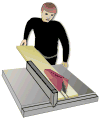Table saw injuries: epidemiology and a proposal for preventive measures
- PMID: 24165629
- PMCID: PMC4154236
- DOI: 10.1097/PRS.0b013e3182a3bfb1
Table saw injuries: epidemiology and a proposal for preventive measures
Abstract
Background: Table saws are ubiquitous devices in professional, home, and school woodshops that have the potential to cause severe injuries. Many of these injuries results in finger and thumb tendon, nerve, and vascular damage or amputation. Long-term outcomes of these injuries can include functional and sensory deficits. Table saw manufacturers are required to equip saws with blade guards to prevent blade contact; nevertheless, treatment of table saw injuries is a common occurrence in U.S. emergency departments.
Methods: The authors performed a literature search using PubMed and the Cumulative Index to Nursing and Allied Health Literature to compile epidemiology data relevant to table saw injuries. The authors also reviewed the U.S. Consumer Product Safety Commission's briefing package on table saw blade contact injuries.
Results: Over 30,000 table saw injuries occur annually. Fingers and hands are the most frequently injured body parts, and lacerations are the most common injuries. Individuals suffering from occupational injuries tend to be younger than those injured during amateur woodworking. A small but important minority of injuries are to students participating in school shop classes. Medical costs for the treatment of table saw injuries are estimated at more than $2 billion every year.
Conclusions: SawStop technology stops the saw blade when contact with skin is made, resulting in a small cut rather than a more complicated laceration or amputation. The application of this novel technology in saw designs can prevent serious injuries that deleteriously affect lives at the personal and societal levels.
Conflict of interest statement
None of the authors or their family members has a financial interest in any of the products, devices, or drugs mentioned in this manuscript.
Figures
References
-
- Underwriters Laboratories; Comission UCPS, editor. UL 987: stationary and fixed eletric tools. 7. 2005.
-
- Ryobi Operator’s Manual - 10 in. Table Saw/BT3000. (Accessed at http://www.raygirling.com/ryobi/ryobi.htm#bladega.)
-
- Conn JM, Annest JL, Ryan GW, Budnitz DS. Non-work-related finger amputations in the United States, 2001–2002. Ann Emerg Med. 2005;45:630–5. - PubMed
-
- Shields BJ, Wilkins JR, 3rd, Smith GA. Nonoccupational table saw-related injuries treated in US emergency departments, 1990–2007. J Trauma. 2011;71:1902–7. - PubMed
-
- Al-Qattan MM. Saw injuries causing phalangeal neck fractures in adults. Ann Plast Surg. 2012;69:38–40. - PubMed
Publication types
MeSH terms
Grants and funding
LinkOut - more resources
Full Text Sources
Other Literature Sources
Medical




